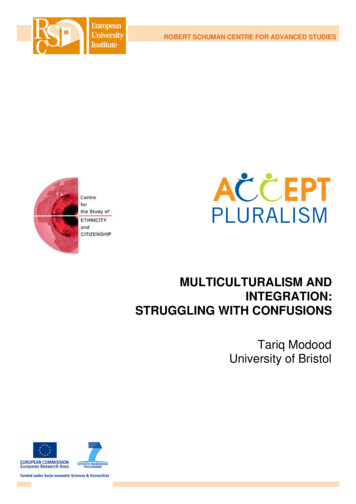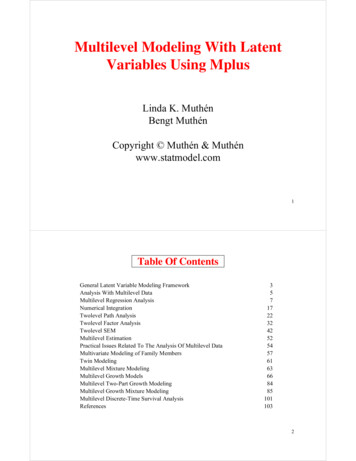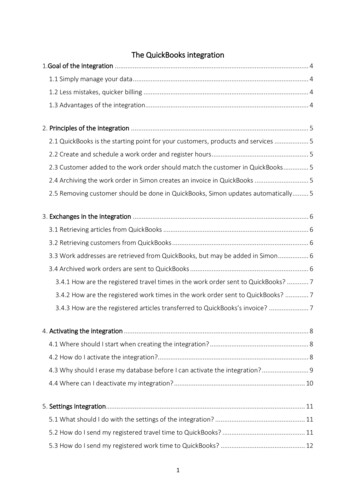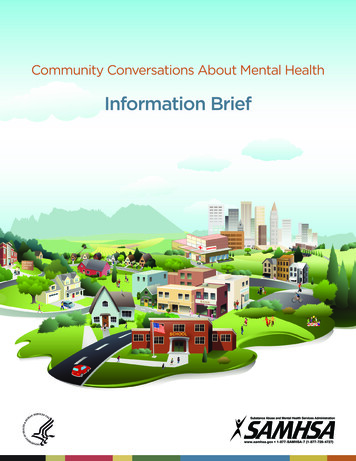
Transcription
ROBERT SCHUMAN CENTRE FOR ADVANCED STUDIESMULTICULTURALISM ANDINTEGRATION:STRUGGLING WITH CONFUSIONSTariq ModoodUniversity of Bristol
2011 Tariq ModoodThis text may be downloaded only for personal research purposes. Additional reproduction for otherpurposes, whether in hard copies or electronically, requires the consent of the author(s), editor(s).If cited or quoted, reference should be made to the full name of the author(s), editor(s), the title, theresearch project, the year and the publisher.Published by the European University InstituteRobert Schuman Centre for Advanced StudiesACCEPT PLURALISM 7th Framework Programme ProjectVia dei Roccettini 950014 San Domenico di Fiesole - able from the EUI institutional repository CADMUScadmus.eui.eu
Tolerance, Pluralism and Social Cohesion: Responding to the Challenges of the 21st Century inEurope (ACCEPT PLURALISM)ACCEPT PLURALISM is a Research Project, funded by the European Commission under theSeventh Framework Program. The project investigates whether European societies have become moreor less tolerant during the past 20 years. In particular, the project aims to clarify: (a) how is tolerancedefined conceptually, (b) how it is codified in norms, institutional arrangements, public policies andsocial practices, (c) how tolerance can be measured (whose tolerance, who is tolerated, and what ifdegrees of tolerance vary with reference to different minority groups). The ACCEPT PLURALISMconsortium conducts original empirical research on key issues in school life and in politics thatthematise different understandings and practices of tolerance. Bringing together empirical andtheoretical findings, ACCEPT PLURALISM generates a State of the Art Report on Tolerance andCultural Diversity in Europe, a Handbook on Ideas of Tolerance and Cultural Diversity in Europe, aTolerance Indicators’ Toolkit where qualitative and quantitative indicators may be used to score eachcountry’s performance on tolerating cultural diversity, and several academic publications (books,journal articles) on Tolerance, Pluralism and Cultural Diversity in Europe. The ACCEPTPLULARISM consortium is formed by 18 partner institutions covering 15 EU countries. The projectis hosted by the Robert Schuman Centre for Advanced Studies and co-ordinated by Prof. AnnaTriandafyllidou.The EUI, the RSCAS and the European Commission are not responsible for the opinion expressed bythe author(s).The Centre for the Study of Ethnicity and Citizenship is based at the University of Bristol. Itsresearch theme recognises the importance of ethnicity to the study of contemporary societies andpolities, and to prospects for social justice and social cohesion. Research focuses on two maindimensions: the politics of multiculturalism, ethno-religious identities, challenges to secularism andthe nation state; and ethnicity and socio-economic structures, with a special focus on racialisedexclusion.Tariq Modood is Professor of Sociology, Politics and Public Policy and Director of the ResearchCentre for the Study of Ethnicity and Citizenship at the University of Bristol.Contact detailsCentre for the Study of Ethnicity and CitizenshipBristol Institute for Public AffairsUniversity of Bristol, 2-3 Priory RoadBristol, BS8 1TX, United KingdomTel: 44 (0)117 33 10929, Fax: 44 (0)117 954 6609http://www.bristol.ac.uk/ethnicity/For more information on the Socio Economic Sciences and Humanities Programme in FP7 ndex o-economic en.html
1
Tariq ModoodDavid Cameron’s declaration, ‘multiculturalism is dead’ has a long pedigree and by no meansconfined to the Right. Multiculturalism has always had its left as well as right wing critics, but theobituaries probably began in 1989 with Fay Weldon: ‘Our attempt at multiculturalism has failed. TheRushdie Affair demonstrates it’ (Weldon, 1989). Whatever our views on the novel, The SatanicVerses, the Salman Rushdie Affair crisis made clear that minority-majority faultline was not going tobe simply about colour-racism; and that multiculturalism could not be confined to ‘steelbands, sarisand samosas’. For some liberals that meant the end of their support as angry Muslims muscled in onsomething that was only meant for secular ‘transgressives’ like gays and black youth. Earlier streetdisturbances were hailed as ‘right on’ politics but a passionate religious identity was too‘multicultural’ for many liberals.1Yet, actually political multiculturalism flourished as Labour came to accept ethno-religiouscommunitarianism as it had previously accepted other assertive identity movements. Muslim faithschools, religious discrimination legislation, incitement to religious hatred, bringing Muslims into thenetworks of governance, including a religion question in the Census – all of these have happened wellafter the original ‘death of multiculturalism’. Indeed, some of them after 9/11 and 7/7, two otherevents that were meant to have killed off multiculturalism. One of the very last acts of New Labourwas the passing of the Equality Act, which for the first time put the claims of the religion and beliefstrand on the same level as race. Initially having religious equality legislation because of an EUdirective, Labour left office with legislation that went well beyond anything found in Europe (on raceas well as a religion).One of the reasons that multiculturalism does not seem to die despite having its last rites continuallyread out by successive government Ministers, like David Blunkett, Ruth Kelly and Hazel Blears, isthat when you think about it there are very few policies at stake. This is clear from David Cameron’sspeech (Cameron, 2011), which despite its emphatic rhetoric has very little policy content. Manypeople worry about residential segegration and inward looking communities. But these are not theresult of policies and population distribution could only be achieved by, to coin a phrase, muscularilliberalism. Residential concentrations have resulted more from poverty, fear of racism, naturalgrowth and ‘white flight’ than self-ghettoisation. Research shows that all minorities – includingMuslims – want to live in mixed neighbourhoods and ghettoes are created by those who move out.This is not ‘state multiculturalism’ and could only be reversed by state racial and religious quotas onwhere people could live. Unless by ‘muscular liberalism’ Cameron means that groups such as Sikhs,Hindus and Muslims are not to be included in the delegation of public responsibilities and resourcesthat are the central idea of the Big Society.It is individual or institutional choices, then, that create outcomes, multiculturalist or otherwise.Schools that choose their pupils, like faith schools, are less ethnically mixed than where pupils areallocated places by local authorities. The expansion of faith schools and indeed the Big Societyconcept in general in so far as it hands over resources and decision-making to neighbourhoods,communities, charities and organised religion should see the development not the decline of ethnoreligious communitarianism.Unlike Cameron I call such state-community partnerships ‘multiculturalism’ and I am in favour ofthem, with certain conditions. One is that it must be within a context of robust individual rights. John1Originally published in H. Mahamdallie (ed), Defending Multiculturalism: A Guide For The Movement,Bookmarks, London, 2011. It is based on my longer contribution to the British Academy 'New Paradigms inPublic Policy' project. I would like I would like to thank my colleagues in the project, especially its chair,Peter Taylor-Gooby, and two anonymous referees for their comments; and also to Bhikhu Parekh, GeoffLevey, Nasar Meer, Varun Uberoi and Aleksandra Lewicki.2
Multiculturalism and IntegrationStuart Mill’s ‘harm principle’: one person’s freedom – whether in the name of multiculturalism oranti-multiculturalism – has to be limited when its clear that others are being harmed. Muslim mendemanding conformity from their womenfolk (eg., the wearing of modest dress) is one example whereindividual rights may be squashed. Legislatures forbidding Muslim women from wearing modestclothes of their choice is an even more egregious example.Yet, society cannot be reduced to individuals and so integration must be about bringing newcommunities, and not just new individuals, into relations of equal respect. This means challengingracism and Islamophobia and so on, not by denying that there are groups in society but developingpositive group identities and adapting customs and institutions that enable that.Equally importantly, we have to talk up what we have in common. We cannot take for granted whatwe have in common but work hard to ensure all varieties of citizens see themselves in our sharedconceptions of citizenship. Such citizenships are imaginatively shaped by our sense of country, aboutwho we are, where we are coming from and where we are going – by our ‘national story’. An out ofdate story alienates the new post-immigration communities, who want to be written into the story –backwards as well as forward. So, multiculturalism is incomplete and one-sided without a continualremaking of national identity.This is an aspect of multiculturalism that has been understated and so the inattentive assume thatmulticulturalism is all about emphasising difference and separatism. In fact its about creating a new,ongoing ‘We’ out of all the little, medium-sized and large platoons that make up the country.In Britain we have made some progress on a number of fronts. In terms of everyday inter-racial andinter-ethnic mixing cities like London are quite remarkable. Yet we have have also made progress inrelation to the communitarian and the national identity fronts. If this does not seem so in relation to thelatter its because of Britain’s elusive, understated and misstated national identity. That goes back tothe exigencies and contingencies of the Union and of running an Empire and certainly predatesmulticulturalism. Even today, ethnic minorities are more likely to say they are British than whitepeople. It is more white reticence than minority separatism that is an obstacle to an inclusive nationalidentity and without overcoming which multicultural nation-building is difficult.Identifying and responding to ‘Difference’It will be clear from what I have said so far that there is a lot of confusion about whatmulticulturalism is and what it is not. This is partly because ‘multiculturalism’ is too oftendefined by its critics, whose sole purpose is to create a straw man to knock down. But its alsobecause there is more than one form of multiculturalism and they relate to integration indifferent ways. I would like to use the rest of my chapter to clarify the key terms ofassimilation, integration, diversity and multiculturalism2. I hope this helps us better to debateproperly, to have a clear idea of what is being said or objected to. I would like to think that myanalysis will bring people closer to my own advocacy of multiculturalism, but it will havesucceeded if it increases understanding of what the issues are.2The concern here is not primarily in relation to socio-economic integration, for which see Loury, Modood andTeles (2005) and Heath and Cheung (2007). The bigger challenge – for another occasion - is to connect thesocio-economic with the issues discussed in this chapter. I would insist however the issues of ‘difference’ are asimportant as the socio-economic in relation to equal citizenship and have to be understood in their own terms.3
Tariq ModoodAssimilation, integration, diversity and multiculturalism each offers their own distinctive takeon freedom, equality and civic unity (what, might be called, ‘fraternity’), namely, some of thecore values of European democracy. The issue or ‘problem’ that all four of these paradigmsare addressing is post-immigration ‘difference’ (Modood 2007). Large scale immigration intoEurope from outside Europe has been by people marked by ‘difference’. The ‘difference’ isnot confined to the fact of migration, or how long the migrants and their families have been inEurope or the fact that they come from less economically developed parts of the world –namely aspects which can be stated structurally and quantitatively. ‘Difference’ primarilyrefers to how people are identified: how they identify themselves (eg., as ‘white, ‘black’,‘Chinese’, ‘Muslim’), how they identify others (again, as ‘white, ‘black’, ‘Chinese’, ‘Muslim’etc) and how they are identified by others (‘white’ etc). These identities fall (not necessarilyunambiguously or discretely) within the fields of ‘race’, ethnicity, religion, culture andnationality, what I will call the forms of difference . They will no doubt be classed or genderedin specific or generalisable ways but the important point from which everything else follows isthat these identities are not reducible to – or, stronger still – are not primarily socio-economicor ‘objective’ in classical sociological terms. The relevant interactions cannot be explained,the position of different actors predicted or even guessed at, political preferences expressedand so on without the explicit or implicit use of the forms of difference.Assimilation is where the processes affecting change and the relationship between socialgroups are seen as one-way, where the preferred result is one where the newcomers do little todisturb the society they are settling in and become as much like their new compatriots aspossible. By smothering difference it is also thought that the occasion for discrimination andconflict are not allowed to take root. From the 1960s onwards, beginning with Anglophonecountries and spreading to others, assimilation as a policy has come to be seen as impractical(especially for those who stand out in terms of physical appearance), illiberal (requiring toomuch state intervention) and inegalitarian (treating indigenous citizens as a norm to whichothers must approximate). It was as early as 1966 that Roy Jenkins, the Home Secretary at thetime, declared that in the view of the British government integration is ‘not a flatteningprocess of assimilation but equal opportunity accompanied by cultural diversity in anatmosphere of mutual tolerance’ (Jenkins 1967, 267). While ‘assimilation’ as a term has cometo be dropped in favour of ‘integration’, yet even today when some politicians use the term‘integration’, they actually, consciously or not, mean what here has been defined asassimilation, so the use of these terms in public discourse must not be taken at their face valuebut critically inspected.Integration is where processes of social interaction are seen as two-way, and where members of themajority community as well as immigrants and ethnic minorities are required to do something; so thelatter cannot alone be blamed for failing to or not trying to integrate. The established society is the siteof institutions - including employers, civil society and the government – in which integration has totake place, and accordingly they must take the lead. The new (prospective) citizens’s rights andopportunities must be made effective through anti-discrimination laws and policies. We need, however,to distinguish between individualist-integration and multiculturalism. The former sees the institutionaladjustments in relation to migrants or minorities as only individual claimants and bearers of rights asequal citizens (Barry 2001). Minority communities may exist as private associations but are notrecognised or supported in the public sphere.Multiculturalism is where processes of integration are seen both as two-way and as involvinggroups as well as individuals and working differently for different groups (CMEB 2000;Parekh 2000; Modood 2007). In this understanding, each group is distinctive, and thusintegration cannot consist of a single template (hence the ‘multi’). The ‘culturalism’ – by no4
Multiculturalism and Integrationmeans a happy term either in relation to ‘culture’ or ‘ism’ – refers to the explicitness that thegroups in question are likely not just to be marked by newness or phenotype or socioeconomic location but by certain forms of group identities. The integration of groups is inaddition to, not as an alternative to the integration of individuals, anti-discrimination measuresand a robust framework of individual rights.The concept of equality is central to multiculturalism as well as to other conceptions ofintegration. The key difference between individualist-integration and multiculturalism is thatthe concepts of group and of ‘multi’ are essential to the latter. Post-immigration minorities aregroups differentiated from the majority society or the norm in society by two kinds ofprocesses. On the one hand, by the fact of negative ‘difference’: with alienness, inferiorisation,stigmatisation, stereotyping, exclusion, discrimination, racism and so on. On the other hand,by the senses of identity that groups so perceived have of themselves. The two together are thekey data for multiculturalism. The differences at issue are those perceived both by outsiders orgroup members – from the outside in and from the inside out – to constitute not just someform of distinctness but a form of alienness or inferiority that diminishes or makes difficultequal membership in the wider society or polity. Multicultural accommodation of minorities,then, is different from individualist-integration because it explicitly recognises the socialreality of groups, not just of individuals and organisations. There may, however, beconsiderable complexity about what is meant by social reality of groups or groupness here,and ideas of groups as discrete, homogeneous, unchanging, bounded populations are notrealistic when we are thinking of multicultural recognition (Modood 2007, 93-7). This leadsus to diversity.Further unpacking Multiculturalism and IntegrationCosmopolitanism emerges by accepting the concept of difference while critiquing ordissolving the concept of groups. Disagreement about the extent to which post-immigrationgroups exist and/or ought to exist and be given political status means that there are two kindsof multiculturalism (Modood 1998; Meer and Modood 2009a). While in public discourse aswell as in academia one or both are referred to as multiculturalism, and often without a fullrecognition that two different ideas are being expressed, I will reserve the term‘multiculturalism’ for the sociological and political position in which groups are a criticalfeature. Where ‘difference’ is positively valorised (or pragmatically accepted) but it is deniedthat groups exist or, alternatively, exist but should not be politically recognised, I shall calldiversity. The contention is that in the early stages of migration and settlement, especially inthe context of a legacy of racism, colonialism and European supremacism, forms of socialexclusion created or reinforced certain forms of groupness such as white and black, but as aresult of social mixing, cultural sharing and globalisation in which dominant identities ofmodernity, such as of race and nation, are dissolving, people have much more fluid andmultiple identities, combine them in individual ways and use them in context-sensitive ways(Hall 1992). For example, the ways that Caribbean-origin Britons have socially blended into a‘multiculture’ and have sought conviviality and sociability rather than separate communitiesmay perhaps not be fully captured as a form of individualistic integration (Gilroy 2000). Whileremaining economically marginal and over-represented in relation to the social problemsassociated with deprived inner cities, they have become leaders of popular culture in terms ofmusic, dance, youth styles and sport, in all of which they have become significantly overrepresented (Hall 1998). To the extent that football teams, Olympiads and televisionprogrammes such as ‘The X Factor’ are central to popular and national identities, Caribbeanorigin people are placed at the centre of British national imaginaries. Moreover, Britain andmost other countries in western Europe have recently experienced and are experiencing a newwave of immigration and will continue to do so, including from within the European Union.5
Tariq ModoodTable 1: Four Modes of Integration*AssimilationObjects of iduals and Individualsgroups marked by ytheirtreatmentbydiscriminatorypractices of stateand civil soceityMinorities mustbe encouraged toconform to thedominant culturalpatternMinoritiesarefree to cultivatetheir identities inprivate but arediscouraged viduals.Presenceof Discriminatorydifferencetreatment must beprovokesactivelydiscriminationeliminatedsoand so is to be everyoneisavoidedtreated as anindividual and noton the basis ofdifferenceAstrong, Absenceofhomogeneousdiscriminationnational identityand nurturing ofindividualautonomy withina national, iallytheirtreatmentbydiscriminatorypractices of stateand civil society,and societal ideas,especially of ‘us’and ‘them’Neither minoritynormajorityindividuals shouldthinkofthemselvesasbelonging to asingle identity butbe free to mix ‘nmatchIndividuals andgroups marked iminatorypractices of stateand civil society,and societal ideas,especially of ‘us’and ‘them’Membersofminorities shouldbefreetoassimilate, to mix‘n match or tocultivategroupmembershipinproportionsoftheir own choiceIn addition toantidiscrimination thepublicspheremustaccommodate thepresence of newgroup identitiesand normsFraternityPeople should be Citizenship andfreetounite national identityacross communal must be remade toandnational includegroupboundariesand identities that areshould think of importanttothemselvesas minorities as wellglobal citizensas majorities; therelationshipbetween groupsshouldbedialogical ratherthanoneofdominationoruniformity.*In all cases it is assumed that a backdrop of liberal democratic rights and values are operative to alarge degree and what is highlighted here is in addition or interaction with them.6Antidiscriminationmustbeaccompanied bythe dethroning ofthedominantculture
Multiculturalism and IntegrationGiven the diversity of the locations from whence migrants are coming, the result, it is argued,is not communities, but a churning mass of languages, ethnicities and religions, all cuttingacross each other and creating a ‘superdiversity’ (Vertovec 2007). This may be setting apattern for the future, and it may be allied to a further argument that globalisation, migrationand telecommunications have created populations dispersed across countries that interact morewith each other, and have a greater sense of loyalty to each other, than they might to theirfellow citizens.In what ways does diversity go beyond individualist-integration? Primarily not as a politics but as anethos: we should value diversity and create the conditions where it is individually chosen. We shouldoppose all forms of imposition of group identities on individuals and therefore the social imaginariesand prejudices by which individuals are inferiorised or portrayed as threatening and so excluded fromfull membership of society. Nor should we require assimilation or conformity to dominant groupnorms; yet, a requirement of communal membership can also be oppressive of individuals and theirlife-chances (Appiah 1994). Inherited or ascribed identities – such as black or Muslim - which slotpeople into pigeonholes not of their choosing, giving them a script to live by should be refused (oftenreferred to in the literature as a transgression of boundaries). They not only reduce the options of thekind of person one can be but divide society up into antagonistic groups.3 The conception is ofmulticulturalism as maximum freedom, for minority as well as majority individuals, to mix with,borrow and learn from all (whether they are of your group or not) so individual identities are personalamalgams of bits from various groups and heritages and there is no one dominant social identity towhich all must conform. The result will be a society composed of a blend of cultures, a multiculture.While this is an attractive image of contemporary society and blends easily with the ideas ofliberal democracy, it has only a partial fit with even, say, London today, let alone many partsof Britain and continental Europe. In some towns and cities, say in Northern England, there isnot a diversity of groups but often just two (eg., Asian Muslims and whites) and minorityindividuals do not float across identities, mixing and matching, but have a strong attachmentto a particular identity. For example, most British Muslims seem to think of themselves interms of ‘Muslim’ and/or ‘British’ (Modood, 2007: 108). The fact of superdiversity isemerging alongside rather than displacing the fact of settled, especially postcolonial,communities, who have a particular historical relationship with Britain, and the politicalsignificance of such communities. Similarly, there are other communities in other Europeancountries with their own historical significance such as Maghrebians in France and the Turksin Germany. Moreover, some groups continue to be much larger than others, and stand out asgroups – in their own eyes and those of others – and are at the centre of public policy anddebate, especially if they are thought to be failing to integrate. Muslims, for example, seem tobe in this category across much of western Europe regardless of the degree of conviviality orsuperdiversity that might be present. Which is not to say that such minority identities areexclusive. Successive surveys have shown that most Muslims in Britain strongly identify withbeing Muslim but the majority also identify as British, indeed are more likely to identify with‘British’ and say they have trust in key British institutions than non-Muslims (Heath andRoberts 2008; Gallup 2009 found the same in Germany, albeit less so in France though Pew2006 found much higher levels of national identification in France than other WesternEuropean countries). Post-immigration hyphenated identities, such as British Muslim, havebecome as commonplace in Britain as they have been in the USA for decades. Similarly,diasporic links as described above certainly exist, and are likely to increase, but I am3British exponents of this view tend however to put some communal identities in a normative, privileged position. Thisparticularly applies to political blackness and to some extent to non-cultural political identities generally (Modood 1994).7
Tariq Modoodunconvinced that the net result is an inevitable erosion of national citizenship: British AfricanCaribbeans and South Asians have families in their countries of origin and in the US andCanada, but there is little evidence that most branches of those families do not feel British,American, Canadian, etc.An important point of difference, then, between the concepts of individualist-integration andmulticulturalism proper is that for the latter, the groups in question, the post-immigrationminorities, are not of one kind but are a ‘multi’. For example, some people will identify with a‘colour’ identity like ‘black’ but there will be others for whom national origin identities (likeTurkish), or a regional heritage (like Berber), or a religious identity (like Sikh) may be muchmore meaningful, expressing forms of community and ethnic pride that are struggling forrecognition and inclusion. And of course these minority identities will interact with wider,societal identities – woman, working class, Londoner, British – in differing ways, expressingthe different experiences, locations and aspirations of different groups. So, both the alternativemodels of multiculturalism as diversity and as ethno-religious communitarianism have somegrounding and meet the political aspirations of some minority groups. Neither works as acomprehensive sociological or political model and should be viewed as complementary(Modood 1998; CMEB 2000; Modood and Dobbernack 2010). Moreover, while recognition ofethnic or religious groups may have a legal dimension, for the most part it will be at the levelof civic consultations, political participation, institutional policies (for example, schools andhospitals), discursive representations, especially in relation to the changing discourses ofsocietal unity or national identity and their remaking. Regardless of the extent to whichrecognition of minority identities in this way is formal or informal, led by the state or thesemi-autonomous institutions of civil society, it does not challenge, let alone displaceindividual rights and the shared dimensions of citizenship. There may however be genuineconcern that some groups at a particular time and in some areas are becoming too inwardlooking; where the concern is primarily about a lack of positive mixing and interactionbetween groups at a local level, community cohesion measures may be an appropriateresponse (Cantle 2001), and where the concern is about self-conceptions and discourses moregenerally, the issue will be about the national or societal identity.Ways in which multiculturalism is not deadThis unpacking of what I mean by ‘multiculturalism’ is also helpful in understanding thosewho say that multiculturalism has failed or that multiculturalism is dead. They may mean toendorse assimilation, individualistic integration or diversity. At the same time they areacknowledging and possibly reinforcing the sociological reality of group difference becausetheir lament is that some groups (especially Muslims) are clearly visible as distinct groupswhen they should not be (they
Tariq Modood 2 David Cameron's declaration, 'multiculturalism is dead' has a long pedigree and by no means confined to the Right. Multiculturalism has always had its left as well as right wing critics, but the obituaries probably began in 1989 with Fay Weldon: 'Our attempt at multiculturalism has failed. The










